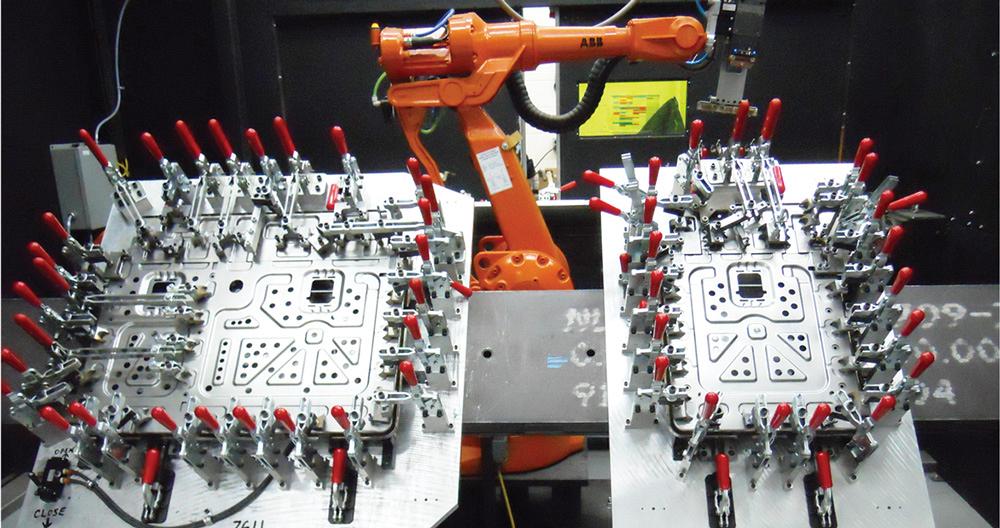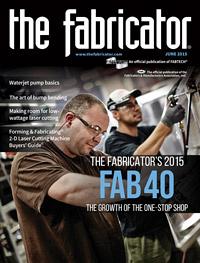Senior Editor
- FMA
- The Fabricator
- FABTECH
- Canadian Metalworking
Categories
- Additive Manufacturing
- Aluminum Welding
- Arc Welding
- Assembly and Joining
- Automation and Robotics
- Bending and Forming
- Consumables
- Cutting and Weld Prep
- Electric Vehicles
- En Español
- Finishing
- Hydroforming
- Laser Cutting
- Laser Welding
- Machining
- Manufacturing Software
- Materials Handling
- Metals/Materials
- Oxyfuel Cutting
- Plasma Cutting
- Power Tools
- Punching and Other Holemaking
- Roll Forming
- Safety
- Sawing
- Shearing
- Shop Management
- Testing and Measuring
- Tube and Pipe Fabrication
- Tube and Pipe Production
- Waterjet Cutting
Industry Directory
Webcasts
Podcasts
FAB 40
Advertise
Subscribe
Account Login
Search
How fabrication project management drives manufacturing success
Custom metal manufacturing mirrors the movie set
- By Tim Heston
- Updated October 26, 2023
- June 23, 2015
- Article
- Laser Welding

The remote laser welding cell is set up for a job at Duggan Manufacturing. The company can set up several welding jobs at once. Because the shop performs not just the welding but also the machining, trimming, and stamping, the operation can turn around projects quickly.
Some good insights came to Adam Davidson while visiting a movie set. The co-founder of NPR’s “Planet Money” and contributing writer for The New York Times Magazine was on set as a technical adviser because of his reporting on financial events that were being re-created in the movie. What struck him was how well everyone collaborated—carpenters, lighting experts, makeup artists, and everyone else—even though many had never worked together before.
As Davidson wrote early last month, “This approach to business is sometimes called the ‘Hollywood model.’ A project is identified; a team is assembled; it works together for precisely as long as is needed to complete the task; then the team disbands.” He described the model’s current success (news flash: there’s money to be made in movies), and contrasted it with the corporate model that dominated much of the 20th century, during which large corporations produced millions of one product for decades, and people spent years, decades, or their entire lives doing the same job and working at the same company.
Take out the part about the team disbanding, and Davidson’s description paints an accurate picture of a lot of contract metal manufacturing. A more apt title in this business might be the “project-based model.” A team from the front office and shop floor shepherds a project through production. Some projects may be massive, like pressure vessels, industrial platforms, and piping skids. Some projects are tiny, like a bracket that must be formed and inspected in a specific way and tested under certain load so that it can withstand a vehicle crash. Unlike a movie, a project in metal fabrication has various timeframes, from a one-off to blanket orders that last years. But they all still require project management.
When will we schedule this run? The customer demanded several thousand more pieces by this date; how are we going to meet this deadline?
Each job is a project that requires a highly skilled team that, in ideal circumstances, communicates continually to ensure the project runs smoothly. Software can help the communication; so can proper labeling and documentation. But people must act on that knowledge, and they make the project happen. In modern custom fabrication and any other high-product-mix operation (that is, most of U.S. manufacturing), the Henry Ford model—assemble this widget this way, all day, every day—just doesn’t apply.
Fabrication Project Management at Duggan Manufacturing
Tony Pinho has experience with the project-based model. With a background in sheet metal automotive prototyping, he and a business partner launched Shelby Township, Mich.-based Duggan Manufacturing in the late 1990s, which was a boom time for Detroit-area prototyping shops.
“We had very little money, but we were able to take on complex, smaller parts that didn’t require a lot of forming tonnage,” Pinho said. “We kept throwing everything back into the business. We bought better equipment and kept growing. For the first five years, our sales doubled every year.”
In 2006, however, the business started to change. Growth slowed and margins became tighter. So Duggan moved into defense contracting, a growing area with the wars overseas. By the time the company installed its remote laser beam welding cell in 2009, military work made up about 80 percent of company revenue. The company has one 5-kW IPG Photonics fiber laser power source that, thanks to beam switching, feeds two welding cells, one with a stationary head and another with the welding head on a robot arm.
The 80-person company now serves customers not only in automotive and defense, but also aerospace, construction, agriculture, and alternative energy. The team continues to overcome many technical hurdles in pressworking as well as in arc and laser welding. In laser welding in particular, they ensure workpieces have the proper gap, develop proper fixturing, and overcome issues with zinc outgassing in galvanized material.
But what really makes the shop successful goes back to project management, which is especially effective considering the range of technology Duggan has. It isn’t just a laser welding prototype shop. It has a bank of hydraulic presses that perform both conventional and hot stamping. It has several flatbed lasers, press brakes, and a 5-axis laser cutting system—the last ideal for trimming hot-stamped components made of boron steels. Hardening after hot forming, such steels aren’t very kind to mechanical trimming dies.
A typical day for Emil Gogirla, laser technology manager, can include programming the laser welding robots offline, running simulations, then entering the laser welding room (light-tight for safety) to fixture four or five different welding jobs at once. “Once the robot is running, the other side can be loaded or unloaded,” Gogirla said.
He could be running one job with a butt joint to create a tailor-welded blank (one blank with two thicknesses, giving strength only where needed). Another job might involve an assembly with several hundred parts.
Some jobs may require adjustments. Perhaps a trim needs to be adjusted, achieved with a different cutting program on the 5-axis laser, or perhaps machining it to an even closer tolerance. Because the project teams at Duggan handle the entire job—stamping, trimming, machining, electrical discharge machining (EDM), welding, assembly, inspection—they can respond quickly and make the necessary changes. “There’s no one pointing fingers,” Pinho said.
The movie changes, and new plot twists emerge: a new material, a tooling challenge, gap tolerances for welding, and more, but the project teams at Duggan adapt and work to turn the project around as quickly as possible.
Modern manufacturing really boils down to a team of experts working together. Davidson saw that on a movie set. If he had visited Duggan Manufacturing—or any other prototype or custom fabrication operation—he would have seen the same thing.
Images courtesy of Duggan Manufacturing, 50150 Ryan Road, Shelby Twp., MI 48317, 586-254-7400, www.dugganmfg.com.
About the Author

Tim Heston
2135 Point Blvd
Elgin, IL 60123
815-381-1314
Tim Heston, The Fabricator's senior editor, has covered the metal fabrication industry since 1998, starting his career at the American Welding Society's Welding Journal. Since then he has covered the full range of metal fabrication processes, from stamping, bending, and cutting to grinding and polishing. He joined The Fabricator's staff in October 2007.
subscribe now

The Fabricator is North America's leading magazine for the metal forming and fabricating industry. The magazine delivers the news, technical articles, and case histories that enable fabricators to do their jobs more efficiently. The Fabricator has served the industry since 1970.
start your free subscription- Stay connected from anywhere

Easily access valuable industry resources now with full access to the digital edition of The Fabricator.

Easily access valuable industry resources now with full access to the digital edition of The Welder.

Easily access valuable industry resources now with full access to the digital edition of The Tube and Pipe Journal.
- Podcasting
- Podcast:
- The Fabricator Podcast
- Published:
- 04/16/2024
- Running Time:
- 63:29
In this episode of The Fabricator Podcast, Caleb Chamberlain, co-founder and CEO of OSH Cut, discusses his company’s...
- Industry Events
16th Annual Safety Conference
- April 30 - May 1, 2024
- Elgin,
Pipe and Tube Conference
- May 21 - 22, 2024
- Omaha, NE
World-Class Roll Forming Workshop
- June 5 - 6, 2024
- Louisville, KY
Advanced Laser Application Workshop
- June 25 - 27, 2024
- Novi, MI































